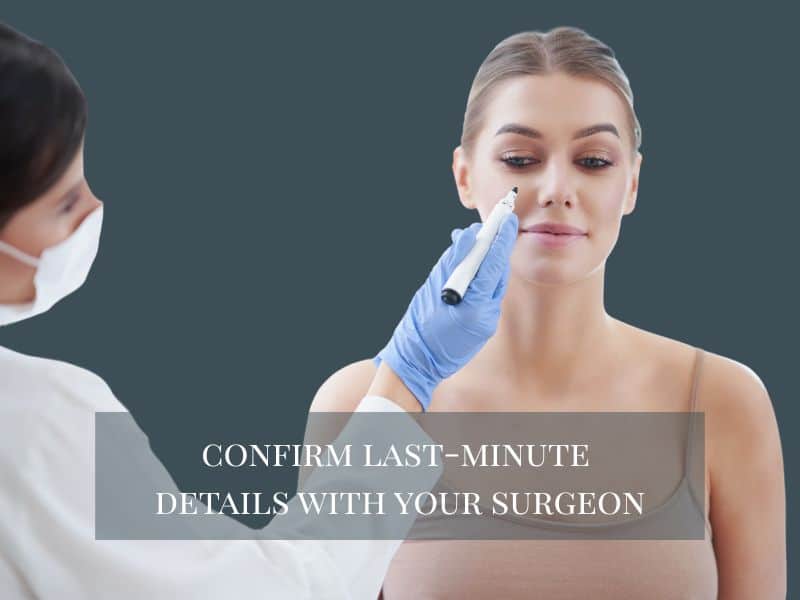Did you know that in 2024, over 350,000 people across the United States chose to have a rhinoplasty procedure? If you’re joining the thousands embracing this popular procedure, you’re not alone! Knowing exactly what to do on the day of rhinoplasty can make the experience a lot smoother and more stress-free.
The morning of your surgery might feel like a whirlwind of emotions of excitement, nerves, and anticipation all rolled into one. But don’t worry. With a few simple steps and a little planning ahead of time, you’ll walk into your surgery feeling confident and fully prepared.
Here’s everything you need to know how to prepare for rhinoplasty and to have a successful and stress-free surgery day.
Confirm Last-Minute Details with Your Surgeon

Before you leave for the surgical center, it’s important that you make sure that all last-minute details are in place. Give your surgeon’s office a call the day before to confirm your arrival time, surgery time, and any specific instructions that they’ve provided.
Some common reminders usually include:
- Avoid wearing makeup, lotions, or jewelry.
- Stop eating and drinking at the instructed time (usually 8 hours before surgery).
- Bring a list of medications and follow instructions about taking them on surgery day.
If you’re uncertain about what to do on the day of your rhinoplasty, this is the perfect time to ask all of your questions. Having open and clear communication with your surgeon and their surgical team will help to ensure you are completely prepared for the day.
What to Wear and Bring to the Surgical Center
What you wear and bring to the surgical center on the day of your rhinoplasty surgery can go a long way toward ensuring you are comfortable and prepared. Loose, comfortable clothing is a must. It’s best if you wear something that opens in the front, like a button-up or zip-up top. This will help prevent you from accidentally bumping your nose when getting dressed after rhinoplasty surgery.
Here’s a checklist of some of the other essentials that you should bring with you:
- ID and Insurance Information: These are usually required at check-in.
- Medication List: Include all prescribed, over-the-counter, and herbal supplements that you regularly take.
- Eyeglasses: If you usually wear contacts, bring glasses instead.
- Comfort Items: Lip balm and a water bottle (to use after rhinoplasty surgery).
- Surgical Forms: Bring any paperwork or consent forms that your surgeon has requested.
Leave any valuable items at home to help minimize your stress levels and keep your focus on what to do on the day of your rhinoplasty.
Guidelines for Eating and Drinking Before Surgery
Fasting before surgery is one of the most important steps in your preparation. Your surgeon will give you all of the detailed guidelines that you need, but in general, you should:
- Stop Eating and Drinking: Most patients must fast for at least eight hours before having surgery.
- Take Medications as Directed: In some cases, your surgeon will allow you to take certain medications with a sip of water. If so, be sure to follow their instructions to the letter.
These fasting rules are very important, and following them will reduce the risk of complications during anesthesia. It is a crucial part of what to do on the day of rhinoplasty (nose job). If you’re unsure about taking medication or the timing of your fasting, call your surgeon’s office to get clarification.
Arranging Transportation and Post-Op Care

Rhinoplasty procedures involves general anesthesia or local (it depends on the complexity), which means you won’t be able to drive yourself home. It can make you feel very sleepy and groggy, so you will need to arrange for transportation with a family member or friend ahead of time.
Many surgical centers won’t allow the procedure to go ahead as scheduled if you don’t bring someone with you who can stay throughout your procedure and is designated to drive you home.
Here are some added tips to make sure your trip home is seamless:
- Confirm Your Pickup Details: Make sure your driver knows how long your surgery will take and when you will need to be picked up. Write down their phone number and give this to the office ahead of time. If they need to stay during the procedure, make sure they plan for this.
- Plan for Post-Op Assistance: Having someone stay with you for at least 24 hours is highly recommended. They can help with tasks like preparing meals, managing medications, and making sure you get all of the rest you need to recover as quickly as possible.
Preparing Your Home for Recovery
One of the best things you can do before your rhinoplasty procedure is to set your home up so you are prepared for a smooth healing process.
Here are some tips that can help you get ready:
- Set Up a Comfortable Resting Space: Choose a quiet area with a comfortable recovery set-up, including pillows to keep your head elevated, blankets, and anything else you’ll need.
- Have Essentials On Hand: Get your prescribed medications, gauze, and ice packs nearby and ready to use.
- Prepare Soft Foods: Soft, low-sodium snacks and meals are an excellent idea for the first few days.
- Avoid Strenuous Activities: Ensure everything you need is easily within reach so that you can minimize any unnecessary movement.
Rhinoplasty Preparation Frequently Asked Questions
What should I wear on the day of my rhinoplasty surgery?
Wear loose, easy-to-remove clothing, such as a button-up or zip-up top. Avoid anything that needs to be pulled over your head. Flat, slip-on shoes are also a good choice for comfort and convenience.
Can I eat or drink before my rhinoplasty?
No. Most plastic surgeons recommend fasting for at least eight hours before nose surgery. You may be allowed to take necessary medications with a small sip of water, but confirm this with your surgeon.
How should I prepare my home for post-surgery recovery?
Set up a clean, comfortable recovery area with all the supplies you’ll need, including prescribed medications, pillows for elevation, and easy access to water and snacks. Add items like a TV or a stack of books for relaxation and entertainment during your recovery.
What should I discuss with my surgeon before my nasal surgery to ensure proper healing?
Before your scheduled surgery date, it’s vital to review your complete medical history with your surgeon to prepare for the nasal surgery.
Since rhinoplasty is usually an outpatient surgery, following all pre-operative instructions is essential for promoting good blood flow and protecting the delicate nasal tissues. This ensures a safe procedure and sets the foundation for proper healing during your recovery.
What should I expect during my recovery period after rhinoplasty, and what can I do to achieve the best final result?
Your rhinoplasty recovery period is a crucial phase for achieving your desired outcome. For the first several weeks, you will experience swelling that gradually subsides to reveal the changes to your facial features. To support your immune system during healing, it is important to follow all post-operative instructions, which may include avoiding certain items like vitamin e supplements that can affect the healing process.
You will receive specific guidance on when it is safe to wear cosmetics and what topical creams you can apply to your skin. If your surgery was also to correct a deviated septum, you should notice an improvement in breathing as you heal.
While many patients are happy with their initial outcome, a second surgery is sometimes needed to address any new issues or refine the results. It is important to be patient, as seeing the final result can take up to a year as swelling fully resolves.
What should I know about the types of rhinoplasty
There are two primary types of rhinoplasty: open and closed. Open rhinoplasty involves an incision on the tissue between the nostrils, offering the surgeon greater visibility for more complex reshaping. Closed rhinoplasty uses incisions hidden inside the nostrils and is often used for more minor adjustments.
Before undergoing surgery, it is important to have an open discussion with your surgeon to make an informed decision. Rhinoplasty can significantly improve breathing by correcting structural issues like a deviated septum.
However, it is crucial to have realistic expectations about the outcome and be aware of possible complications, which can range from swelling to infection.
To support proper healing, it’s often recommended to avoid alcohol before and after the procedure. Understanding these factors will help you decide if the procedure is right for you and can help address both cosmetic concerns and breathing problems.
Will rhinoplasty leave a noticeable scar?
The location and visibility of rhinoplasty scars depend on the surgical technique used. In a closed rhinoplasty, all incisions are made inside the nostrils, so there are no visible external scars.
In an open rhinoplasty, there is a small, carefully placed incision across the columella (the strip of skin between the nostrils). This incision is typically very fine and, with proper healing, fades significantly over time, becoming nearly invisible for most patients.
What is non-surgical rhinoplasty and how long does it take?
Non-surgical rhinoplasty, also called a liquid nose job, uses dermal fillers to reshape and contour the nose without surgery. The procedure takes only 15-30 minutes in an office setting and allows you to return to normal activities immediately afterward.
Non-surgical rhinoplasty results are temporary, typically lasting 6-18 months depending on the type of filler used and individual metabolism. Unlike surgical rhinoplasty which provides permanent changes, the liquid nose job offers adjustable results that can be tweaked as desired. The procedure can be repeated to maintain results, and the effects are completely reversible if needed.
book your consultation with Aesthera Plastic Surgery
Your rhinoplasty journey is an exciting one, and experienced surgeon Dr. CV Chegireddy who holds board certification is here to provide surgical expertise and care. By thoroughly preparing for your rhinoplasty with Dr. CV, you’re setting yourself up for a successful day and a smooth recovery afterward.
Remember, if you have any last-minute questions about what to do on the day of your rhinoplasty, Dr. CV and his team are here to give you all of the guidance and reassurance you need.
Now that you know what to do on the day of your rhinoplasty, you can feel confident about preparing for your procedure.
If you’re considering rhinoplasty or have questions about the process, schedule a consultation with Dr. CV Chegireddy at Aesthera Plastic Surgery today. We’re here to help you every step of the way!



